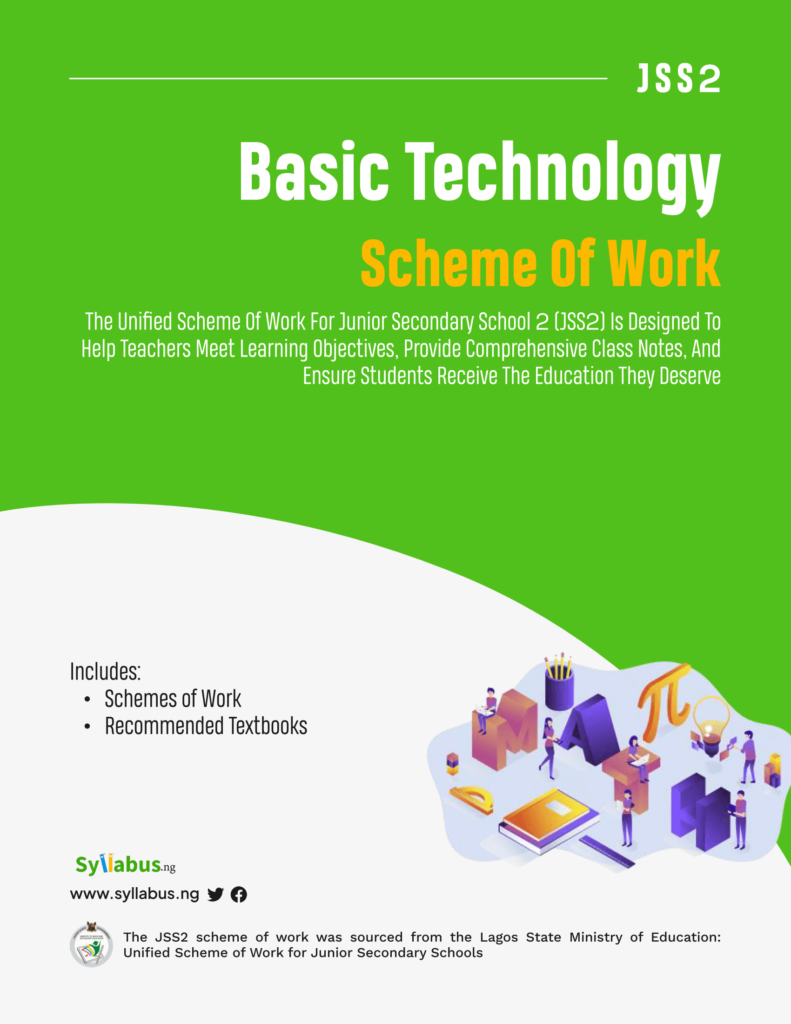Download the Junior Secondary School 2 (JSS2) Unified Scheme of Work for Basic Technology to serve as a guide for educators

Home » JSS2 Scheme of Work » JSS2 Basic Technology Scheme of WorkBasic Technology for Junior Secondary Schools 2 is a foundational subject that introduces students to essential technological concepts, skills, and knowledge. It provides students with a fundamental understanding of principles in technology aiming to equip them with practical skills relevant to daily life and future career prospects.
The Basic technology scheme of work covers various areas such as simple machines, woodworking, metalworking, and introductory computer skills. By carrying out theoretical learning and practical activities, students develop problem-solving abilities, creativity, and critical thinking skills essential for navigating the complexities of the modern world.
The study of basic technology in JSS2 serves as a stepping stone for further specialization in technology-related disciplines as students advance in their academic pursuits.
In junior secondary schools, how students are assessed in Basic Technology can differ from school to school. However, typically, they are evaluated through tests or quizzes (Continuous Assessment Tests), practical exercises, and end-of-term exams.
Grading usually follows a scale from A to F, with A representing excellent performance, typically scoring around 70% or 80%, and F indicating failure, usually below 45% or 40%.

Know what’s expected of you as an educator
Download the Lagos State Unified Scheme of Work for JSS2 Basic Technology
| LAGOS STATE MINISTRY OF EDUCATION: UNIFIED SCHEMES OF WORK FOR JUNIOR SECONDARY SCHOOL | ||
| Basic Technology Scheme of Work for Junior Secondary School 2(JSS2) | ||
| Class | J.S.S 2 | |
| Subject | Basic Technology | |
| Term | First Term | |
| Week | Topic | Breakdown |
| 1 | FIRST AID | I. Definition II. Materials III. Application of Simple First Aid |
| 2 | RESCUE OPERATION | I. Meaning of Rescue Operations II. Different Aspects III. Steps Involved in Rescue Operations |
| 3 | MATERIALS USED THEIR COMMON USES I | I. Wood – State the Common Uses of Wood II. Metal – State and Explain the Common Uses of Metal, Specific uses of Ferrous and Non Ferrous Metals and their Alloys |
| 4 | MATERIALS USED THEIR COMMON USES II | I. Ceramics/Glass II. Rubber III. Plastics |
| 5 | GEOMETRIC CONSTRUCTION | I. Lines – Identify and Draw Lines of Various Types II. Definition, Types and Uses III. Bisection and Division of Lines |
| 6 | ANGLES I | Definition, Types and Uses. |
| 7 | ANGLES II | Bisection and Construction of Angles – 90, 45, 60, 30 etc |
| 8 | TRIANGLES | I. Definition and Types II. Sketch Types of Triangle and Parts of a Triangle |
| 9 | TRIANGLES | I. Construction of Various Types of Triangles II. Circumscribing, Inscribing, Escribing Circles to a given Triangle |
| 10 | CIRCLES | I. Definition II. Types and Parts of a Circle III. Construction of Targets and Normal to a given Circle and Two to Two Equal and Unequal Circles |
| 11 | REVISION | |
| 12 | EXAMINATION | |
| Term | Second Term | |
| Week | Topic | Breakdown |
| 1 | REVISION OF LAST TERM’S WORK | |
| 2 | QUADRILATERALS | I. Definition (Define, Identify and Construct Regular and Irregular Quadrilaterals) II. Types/Sketches III. Constructions |
| 3 | POLYGONS | I. Definition (Define, identify and Construct Regular and Irregular Polygons) II. Types/Sketches III. Constructions |
| 4-5 | AREA OF PLANE FIGURES | I. Enlargement/Reduction of Plane Figures (Regular and Irregular) II. Determination of Areas of Regular and Irregular Figures |
| 6 | WOODWORK MACHINES | I. Definition (Identify and State the Uses) II. Types and Uses III. Care and Maintenance |
| 7 | METAL WORK MACHINES I | I. Definition (Identify and State the Uses) II. Types and Uses III. Care and Maintenance |
| 8 | METAL WORK MACHINES II | Care and Maintenance (Identify the Processes Involved) |
| 9 | FRICTION I | I. Definition and Causes of Friction II. Effects III. Advantages and Disadvantages |
| 10 | FRICTION II | I. Reduction of Friction II. Lubrication – Types and Uses |
| 11 | REVISION | |
| 12 | EXAMINATION |
| Term | Third Term | |
| Week | Topic | Breakdown |
| 1 | REVISION OF LAST TERM’S WORK | |
| 2 | BELT AND CHAIN DRIVE I | I. Definition II. Types, Uses |
| 3 | BELT AND CHAIN DRIVE II | I. Advantages and Disadvantages II. Compare Belt and Chain Drives |
| 4 | GEARS I | I. Definition II. Types and Uses |
| 5 | GEARS II | I. Gear Ratio and Speed II. Functions of Lubricants in Ge |
| 6 | HYDRAULICS AND PNEUMATICS MACHINES | I. Definition II. Types and Uses III. Operation |
| 7 | SITE PREPARATION | I. Definition tools II. Classification of Tools/Plants Use for Site Preparation |
| 8 | SETTING OUT | I. Definition, Tools used during Setting Out II. Evacuation/Timbering |
| 9 | BUILDING SERVICES | I. Taps – Identify the various Fittings required, State the various Types of Tap) II. Water Supply |
| 10 | BUILDING PROJECTS | Termly Practical Work |
| 11 | REVISION | |
| 12 | EXAMINATION |
The following textbooks are recommended for Basic Technology in J.S.S.2.

Know what’s expected of you as an educator
Download the Lagos State Unified Scheme of Work for JSS2 Basic Technology